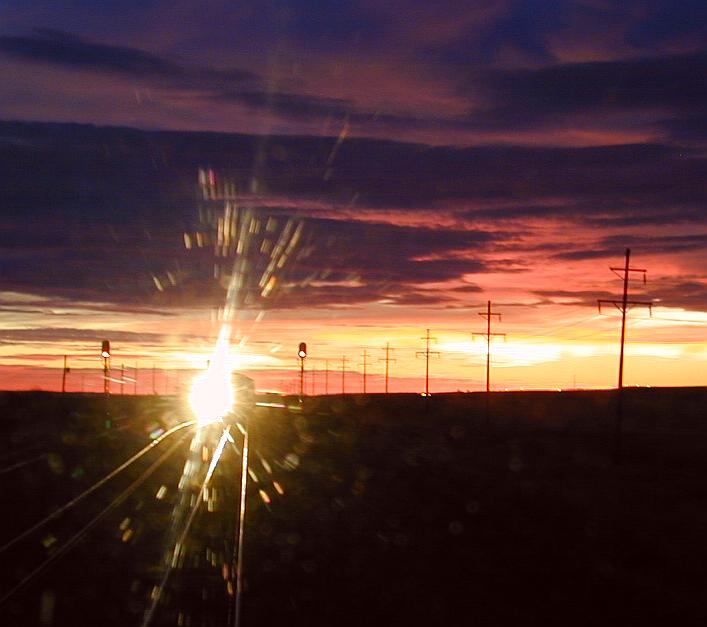
Moran Sunrise It is sunrise at 5:45am on April 14, 2002. We are stopped on the mainline of BNSF's Bighorn Sub at Moran Junction, Montana on the V-PTLKCM. The lead unit is BNSF 553, a GE B40-8. A westbound coal train is just starting onto the connection loop that will turn it east towards the Great Lakes boat docks at Superior, Wisconsin. The 553's windshield is slightly abraided causing the starburst effect of 8981's headlight.

Bighorn Mountains On April 11, 2002 we are on the V-TACMEM (Vehicle train - Tacoma, Washington to Memphis, Tennessee). The power is two EMD (OWY) SD60s and the location is just 5 miles from home. We are at milepost 705.4 on the Bighorn Subdivision where the sub's namesake mountains are straight ahead. Although we are eastbound the compass heading at this point is southwest.
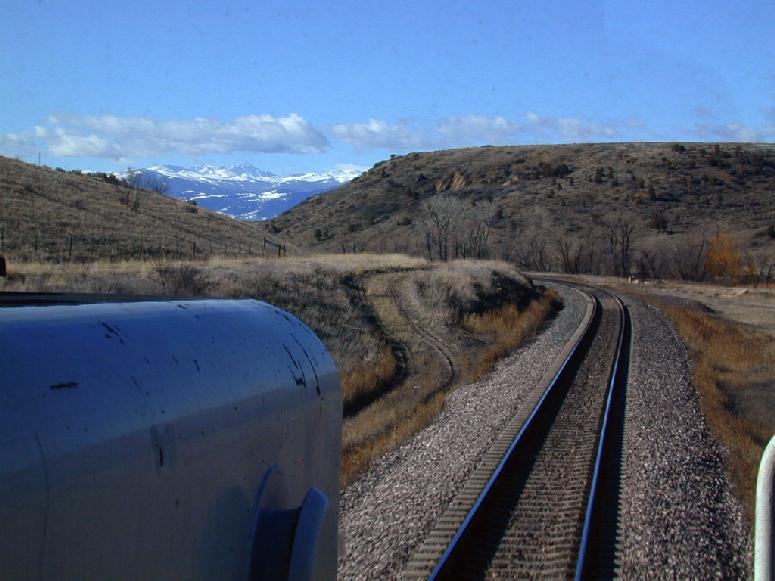
Through Kiewit the railroad is a series of tight S curves. The track will curve back to the right again before passing East Kiewit. One of the home signals for the CTC control point can be seen at the left edge of the picture below.In about 7 minutes I'll be stopping at the Sheridan, Wyoming depot to get off and go home. It has been a long night. We were called on duty for 3:15am (a 1:45am phone call) and it is now 9:30am.
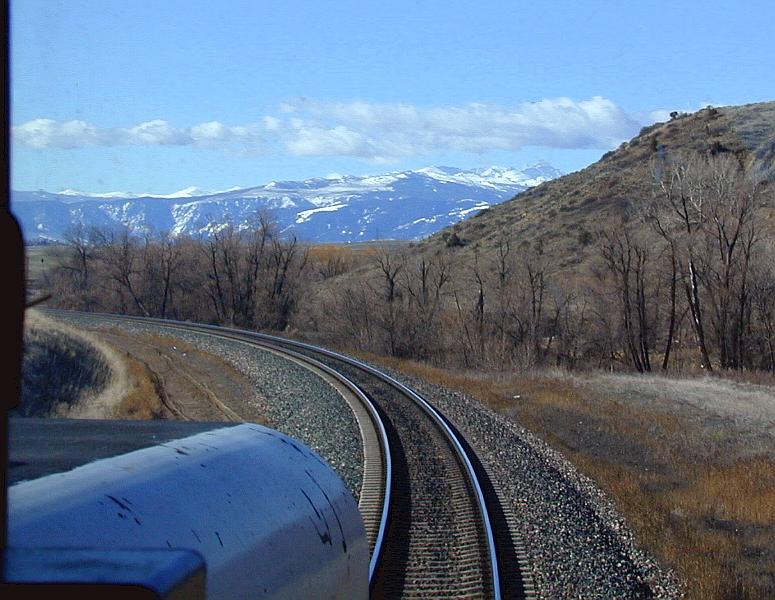
Montana Rail Link's Laurel Yard The MRL's Laurel, Montana yard is my away from home terminal. The next two pictures taken on April 5, 2002 are a west looking overview of the yard from the highway overpass at the east end.A switch engine with one of MRL's radio remote control cars (caboose) sits just in the clear on Eastbound track 2. The long string of tank cars in the center are on Westbound track 1. In the background forty miles away the Beartooth Mountains reach skyward.
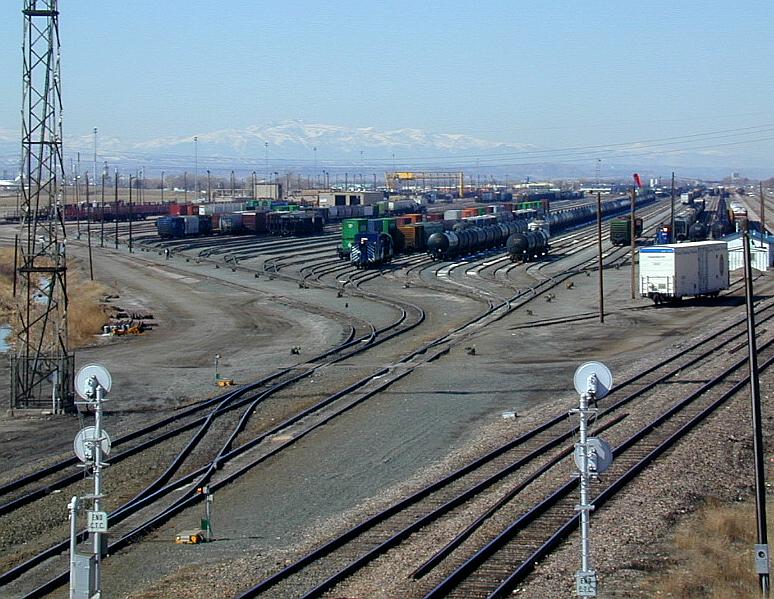
In the following photo you are looking straight up Westbound track 6. The two curving tracks on the right used to be the mainlines but are now just two more yard tracks, WB 14 and WB 15, as CTC ends at the foreground signals. The white reefer car is sitting on what used to be the caboose track in the days when all trains had them.This was mid-morning on an unusually light traffic day. Normally the yard is totally plugged and many times there are 2, 3, or even 4 trains waiting to get into the yard.
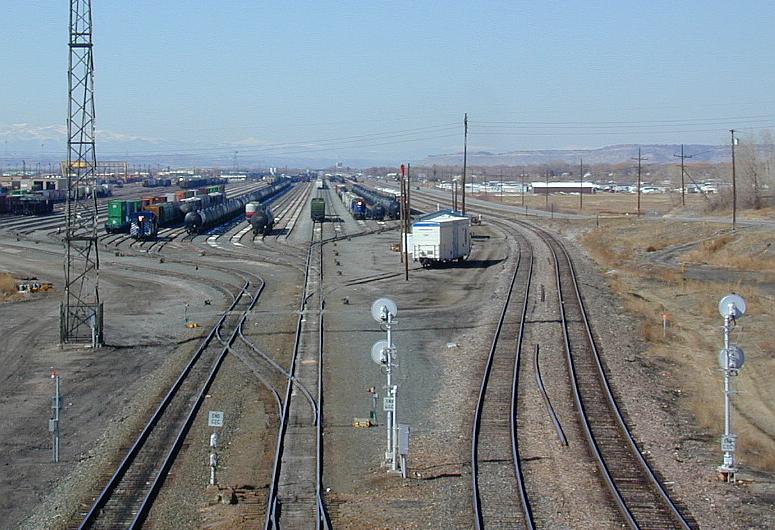
Standing on the same overpass but looking off the opposite side (looking east now) you get the view below. The trackage under the overpass between these home signals and the ones you see in the above photos is a CTC control point named Mossmain.The two tracks on the right are the eastbound and westbound yard switching leads. The two mains are under the cantelever signal mast. Just this side of the signals you can see the ties of a former crossover. That crossover was removed in 1996 when the new CTC control point of Shilo was installed 2000 feet east of here. The crossover was moved to Shilo where the east leg of the wye comes out onto the mainline so eastbounds coming off the Great Falls line can crossover to the eastward main.
The foreground track curving off to the left is the West Wye which leads to the BNSF Laurel Sub to Great Falls, Montana. The Laurel Sub is a former Great Northern route while all the other tracks in these Laurel photos are former Northern Pacific. Note the power switch type derail just inside the interlocking. It protects crews in the yard from runaways coming off the hill. It might protect the yard crews but I would not want to be on this overpass if a runaway makes use of the "derail". It "aims" the runaway train right into a bridge support!
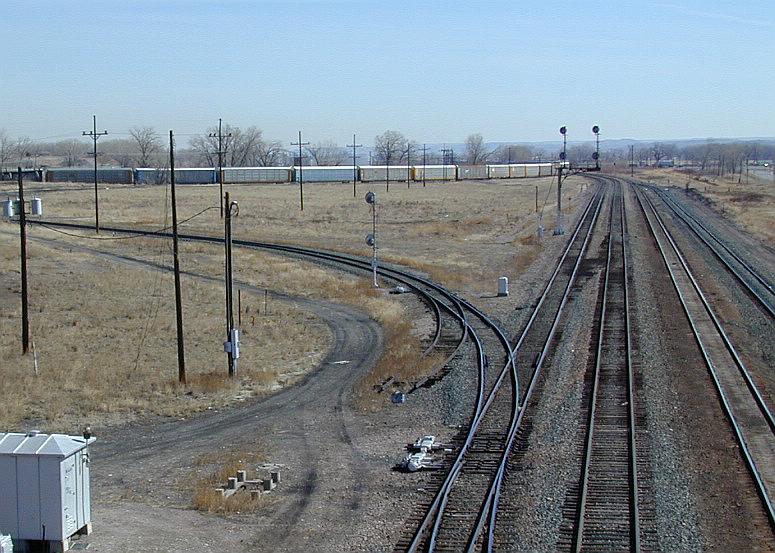
In the background a westbound vehicle train is bypassing the MRL by taking the old Great Northern route to Great Falls, Shelby, and Marias Pass. It is traversing the East Wye. This is a very unusual move because autoracks and double stacks are prohibited from using the Laurel Sub due to low tunnel clearances. The crew questioned this but a trainmaster told them to "just watch it carefully through the tunnels". My question would be just what or where do you "watch"? Rimrocks Tunnel is just ahead and it is curved. You can only see a few hundred feet at best account of the curvature and once both portals are out of sight it is BLACK in there. I know because I have walked the length of that tunnel. To make matters worse the south portal is wood and the first thousand feet of the tunnel has a timber lining. The remaining 2/3rds of the tunnel is bare rock. You'd have no idea just where the tightest clearances are and you could not see in the dark anyway. Apparently the train made it through with no scrapes. It is a good thing the roofs of autoracks are curved at the sides. A Great Falls conductor told me he had "rounded off" the corners on a number of containers on a double stack he took through the tunnel one night that was put on his train by mistake.
To see a view of this area from another perspective, looking under the bridge, Go Here.



| Return to Tales index | My Home Page | E-Mail me |
Created 04-15-2002
Updated 04-14-2002